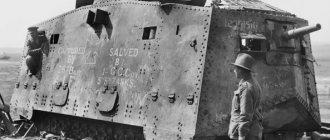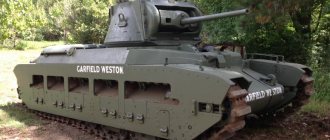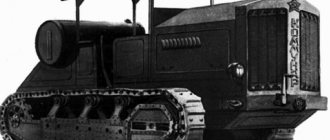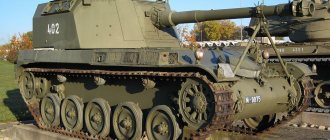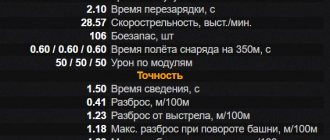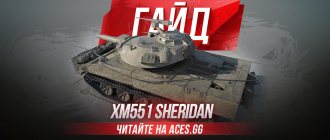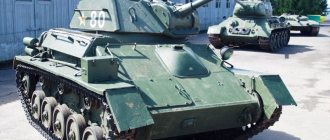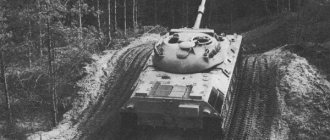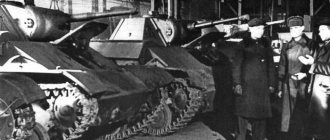Characteristics of the light tank Mk.III "Valentine"
A country:Great BritainType:Light tankDate of issue:1938Length:5.41 mWidth:2.63 mHeight:2.27 mArmor, forehead:60 mmArmor, side:30 mmArmor, tower:65 mmCrew:4 peopleEngine:1x AEC A190 135 hpTravel range:126 kmMaximum speed:25 km/hWeight:16 tWeapons:1x 40mm OQF Mk IX (52 rounds), 7.92mm Besa (3150 rounds)
Characteristics are given for the Mk III Valentine (II) light tank model
The history of the creation of the light tank Mk.III "Valentine"
The English light tank Mk.III "Valentine" (Infantry Mk. III Valentine) was developed on the initiative in 1938. The tank most likely received its unusual name from an abbreviation of the full name of the Vickers-Armstrong concern (“Vickers-Armstrongs Ltd., Elswick & Newcastle-upon-TYNE”), or from the name of Valentine Carden, the company’s designer.
According to the English classification, the Valentine was classified as an infantry tank, but the designers wanted to create something more universal - combining both the features of a cruising and infantry tank - suitable both for supporting infantry and for independent raids on enemy territory, after breaking through the defense line .
The first vehicles entered service in May 1940, and production of the tank ended at the very beginning of 1944. Mk.III "Valentine" was produced both in England itself (6854 units) and in Canada (1420 units).
3782 Valentines were the first combat vehicles delivered to the Soviet Union under Lend-Lease, and along with the Soviet T-70 and T-60 light tanks they took part in the Battle of Moscow. Subsequently, the Valentine was used by the Soviet army until 1943, when light tanks began to be withdrawn from the main military personnel everywhere. True, all these vehicles underwent modifications, and in particular, instead of the standard 40-mm cannon, they received a 57-mm caliber gun.
Light tank Mk.III "Valentine"
Soviet tank crews positively assessed the combat qualities of the vehicle, which, although inferior to similar Soviet vehicles in terms of maneuverability, speed and fire power, had more durable armor and fairly high survivability.
The tank performed equally well in North Africa, during the Normandy landings, and in battles with the Japanese in Burma and Madagascar - the geography of the tank’s use speaks for itself.
Mk.III "Valentine" was in service with Great Britain (including New Zealand and Australia), Canada, the Soviet Union, Iraq, Turkey, Portugal, Poland, and France. The last Valentines finished service only in 1955 (New Zealand).
Racing with fashion
However, the Valentine Mk.X was not lucky either. The fact was that in the summer of 1942, American Lee and Grant tanks with universal 75-mm guns went into battle, and in the fall - more advanced Shermans. Just in the fall of 1942, the British began to think about their own large-caliber gun. In November 1942, a 12-pounder gun with a muzzle brake from . The gun seemed like a pretty attractive option for rearming a tank. The penetration of the armor-piercing projectile was slightly higher than that of the 6-pounder, but the tank now had a powerful high-explosive fragmentation projectile. However, another suitable option soon appeared.
Since the British liked the American 75-mm guns, and standardization of the shells would have made production easier, the ballistics of the gun were used in the development of a new gun based on the 6-pounder. The new 75-mm gun, officially called Ordnance, Quick Firing, 75 mm (in documents also referred to as 6-pdr/75 mm and 75 mm QF) was placed in any tank that already had a 6-pounder. As a result, increasing the firepower of the Valentine turned out to be quite simple. The 75-mm cannon in the turret of the Valentine IX tank with registration number T.66991 entered testing at Lulworth in March 1943. As a standard for the same tests, the regular Valentine Mk.IX with registration number T.67160 was received.
"Valentine" Mk.XI, the latest version of the vehicle. It already had a 75 mm cannon and a coaxial machine gun
When firing at stationary targets from 500-1000 yards and at moving targets from 1400 yards, the guns performed equally well. Gunners complained that the tank shook noticeably more when firing a 75 mm gun than a 57 mm gun. Testers noted that the 75mm round's lower muzzle velocity and clearly visible explosions made it easier to observe hits. The 75 mm gun also produced less smoke when fired, which aided observation from the tank. Despite the presence of a muzzle brake, the shot raised less dust than the 6-pounder. Basically, clouds of dust appeared 15 feet to the sides of the car and quickly settled.
When firing at a target at a distance of 550 yards while moving at a speed of 5-7 mph, the 75mm gun showed another disadvantage. Loading took longer, both due to the larger and heavier cartridge and the nature of the ammunition racks, which were originally designed for the 6-pound cartridge. Having removed the 75 mm cartridge from the stack, the loader still had to remove the bracket from it. These factors did not affect the rate of fire when firing on the move, since the gunner aimed slowly, but testers noted that the maximum rate of fire of the 6-pounder when firing from a standstill would be higher.
"Valentine" Mk.XI artillery observers and "Churchill" Mk.VII, Hoch, Germany, 1945
The rate of fire was limited by another factor: toxicity. The concentration of carbon monoxide after firing a 75 mm gun was approximately twice as high as in a tank with a 6 pounder. It was possible to fire only with a working engine; one fan in the turret could not cope with the powder gases.
The gun behaved well - the testers noted only two stuck cartridges due to dust getting into the chamber. Some shells could not be loaded due to deformation during delivery. The rollback system worked satisfactorily. The recoil length of the gun at the beginning of the test was 11.35 inches and by the fifth shot it increased to 11.6 inches, after which it remained stable.
As usual, testers found a lot of shortcomings, especially in the design of the ammunition rack. However, this did not stop them from recognizing that the new gun had many advantages over the 6-pounder.
"Valentine" Mk.XI as an artillery observer vehicle, Hopsten, Germany, 1945
The new tank was put into service under the name "Valentine" Mk.XI. The design of production tanks was based on the Valentine Mk.X, not the Mk.IX, so these tanks also had coaxial machine guns. This is where the construction of the “Valentines” ended. The light and simple tank came in handy when the British needed to replenish their tank fleet after the defeat in France in 1940, but by 1943 supplies from the United States had largely solved the quantity problem. The once impressive 60 mm thick armor was no longer suitable, since cruising tanks already had more effective protection. “Valentine” could not compete with them in speed from the very beginning. The tanks were still used as chassis for special vehicles, but even the installation of more powerful guns could not significantly extend the life of the Valentine.
Design of the light tank Mk.III "Valentine"
The British light infantry tank Mk.III "Valentine" had a classic layout with a rear-mounted engine compartment and a front-mounted control and transmission compartment. The box-shaped body was assembled from rolled steel armor plates, attached to the frame using rivets, bolts and welding.
The fighting compartment occupied the middle part of the tank, the tank's turret was located above the fighting compartment in the turret box.
The crew of the Mk.III "Valentine" tank consisted of three people: a tank commander, a loader and a driver. The positions of the tank commander and loader were located in the turret (beginning in 1942, a 4th crew member was added - the gunner).
The crew boarded the tank through two hatches - in the roof of the front part of the hull (driver's hatch) and in the roof of the turret (commander and loader). In the three-man turret (1942), the turret had not 1, but 2 hatches - for the commander, loader, and gunner.
The turret of the Mk.III "Valentine" light tank had a cylindrical shape and was curved from a single armor plate, which made it possible to achieve relatively uniform armor over the entire surface (like the "Matilda 2" - these tanks are generally structurally similar). The roof of the turret was also a single steel sheet; in the rear of the turret there was a pronounced aft niche, and in the front there was a rectangular hole cut out into which the armored mantlet of the gun was installed. The thickness of the armor of the mantlet and turret plate was the same and amounted to 65 mm.
The chassis of the light tank Mk.III "Valentine" included on one side:
- six large-diameter road wheels, grouped in blocks of three, and mounted on coil springs.
- three support rollers
- drive wheel (front), guide sprocket wheel (rear).
Modifications of the light tank Mk.III "Valentine"
- Mk III Valentine I (Mk I) is the basic modification of the Valentine light infantry tank. It featured a gasoline engine AEC A189 (135 hp). Crew 3 people.
- Mk III Valentine II (Mk II) - “Valentine” with an AEC A190 diesel engine (135 hp) and an additional external fuel tank.
- Mk III Valentine III (Mk III) - Valentine with a three-man turret and an AEC A190 engine. Crew - 4 people.
- Mk III Valentine IV (Mk IV) - "Valentine" Mk II with a GMC 6-71 diesel engine.
- Mk III Valentine V (Mk V) - "Valentine" Mk III with a GMC 6-71 diesel engine.
- Mk III Valentine VI (Mk VI) - Canadian “Valentine”, completely similar to the Mk IV model.
- Mk III Valentine VII (Mk VII) - "Canadian Valentine" (VI), but equipped with a 7.62 mm M1919A4 machine gun instead of the BESA.
- Mk III Valentine VIIA (Mk VIIA) - “modified Canadian Valentine”. Design changes are insignificant.
- Mk III Valentine VIII (Mk VIII) - “Valentine” with a two-man turret armed with a 57 mm QF-6 cannon, without a machine gun. Engine AEC A190.
- Mk III Valentine IX (Mk IX) - “Valentine” with a two-man turret armed with a 57 mm QF-6 cannon, without a machine gun. Engine GMC 6-71.
- Mk III Valentine X (Mk X) - Similar to the Mk IX, but with a redesigned turret with a self-contained BESA machine gun mount.
- Mk III Valentine XI (Mk XI) - “Valentine” with a 75 mm QF 75 mm cannon in a turret similar to the Mk X. The GMC 6-71 engine is boosted to 175 hp. With.
- The Mk III Valentine CS is a New Zealand version of the "close support" tank based on the Mk III, equipped with a 76 mm howitzer instead of a 40 mm gun.
Source: based on materials from open sources on the Internet
Big gun at any cost
As Vickers employees predicted, deliveries of new Valentines began only in 1942. By this time, a significant problem had emerged: the 2-pounder (40 mm) gun, which began to be developed back in 1932, had become outdated after 10 years of service. British tank crews were convinced of this back in 1941. While the frontal armor of the Pz.Kpfw.IV, consisting of two 30-mm plates, could still be penetrated from 500 yards (400 meters), the surface-hardened frontal armor of the Pz.Kpfw.III, 50 mm thick, could only be penetrated at point-blank range, and even then not in all cases.
There was a solution: back in 1938, the artillery department initiated the development of a more powerful 6-pounder (57 mm) gun. At first, it did not impress the British General Staff, but they returned to the topic in 1941. At first, they planned to install the gun only on the Crusader Mk.III, but later the Churchill Mk.III also received a new gun.
These vehicles were not ideal carriers of the new weapon. The Crusader did not meet the requirements of British tank crews not only in terms of armament, and by the beginning of 1942 work on its replacement was already nearing completion. Nobody was going to change the Churchill, but this 40-ton machine could not become truly mass-produced. There was only one option left: to install a 6-pounder in the Valentine, but squeezing a large gun into the tank's turret, where there was not exactly room for two crew members with a 2-pounder, was not easy.
Valentine Mk.IX with 6-pounder gun and GMC 6004 engine, Bovington Tank Museum. The Valentine Mk.VIII version with the AEC A190 engine was never built
The new turret was based on the Valentine turret Mk.III and Mk.V. Since the commander was already resting against the 2-pounder fence, when installing the 6-pounder gun, he again began to perform the duties of a loader. The front of the tower also had to be redone. For the sake of the new gun, the designers sacrificed not only the third crew member in the turret - the auxiliary weapons, represented by a 50-mm breech-loading mortar and the Beza machine gun, also disappeared from it.
If the lack of a mortar was partially compensated for by installing smoke mortars on the side of the turret, then there was nowhere to place a machine gun. However, the tank was needed even in this form. As before, two modifications were planned: “Valentine” Mk.VIII with an AEC A190 engine and “Valentine” Mk.IX with a GMC 6004 engine. As a result, the “eight” was never built: so many American engines were supplied to the UK that with the production the domestic AEC A190 could be forgotten.
Tanks "Valentine" Mk.IX, Tunisia, 1943. To install a powerful 6-pounder, we had to abandon the coaxial machine gun and the fourth crew member
The prototype Valentine Mk.IX with 6-pounder arrived at the Lulworth gun range in June 1942. The tests were completed by June 17. The tank performed well, demonstrating the ability to fire at stationary and moving targets at distances of up to 1,500 yards. Firing on the move, the Valentine hit targets from 700 yards. Shooting using the manual trigger was quite tight, requiring 60 lb (27 kg) of force, but the electric trigger cut the force in half. The location of the ammunition was considered successful: the loader could reach the cartridges without much difficulty. As often happens, the test site specialists compiled a list of shortcomings that needed to be corrected, but on the whole the tankers were satisfied with the new vehicle.
It was also necessary to test the gas content of the fighting compartment: a larger gun produced more powder gases. Like other “Valentines”, the “nine” had flaps on the partition of the engine compartment, when opened, the engine sucked air from the fighting compartment. An exhaust fan above the gun also helped with the release of powder gases by drawing air through a hose located above the gun. Tests were carried out in two modes: with maximum ventilation (the motor is on and the dampers are open), and only with an exhaust fan. It turned out that one fan was not enough to completely clean the air in the fighting compartment.
Maintaining a rate of fire of one shot every minute, the tank crew would have been poisoned within an hour. Landfill staff noted that the fan was poorly positioned, which reduced its effectiveness. The design of the fan did not allow it to draw more than 20 cubic feet (0.566 cubic meters) of air per minute, while to effectively clear the fighting compartment of propellant gases it was necessary to suck out 150 cubic feet (4.24 cubic meters) per minute. For safe shooting, it was necessary to start the engine at high idle speeds and open all the valves. Instructions transmitted to the troops advised using the fan only if the motor failed, and in all other cases, opening the dampers when firing.
Tests of the protection of the new gun mount from lead splashes were carried out in August. On the sides, the installation was reliably protected by slats, but when fired with armor-piercing bullets of .303 caliber (7.7 mm), splashes penetrated into the fighting compartment from the bottom of the mantlet at the maximum elevation of the gun and from above at the maximum declination. Spray could also enter the fighting compartment through the sight hole. Armor-piercing bullets were also able to temporarily jam the gun. The pistol loop also turned out to be a vulnerable spot. It was possible to jam the hatch and hit the crew with lead spray even by shooting ordinary, non-armor-piercing bullets.
"Valentine" Mk.X in service in the Red Army. The main novelty of this tank was the return of the coaxial machine gun
Despite the superiority of the new Valentine over its predecessor, the design had one inherent flaw. The 6-pounder, like the 2-pounder, did not produce high-explosive fragmentation shells. If on the old Valentines it was possible to hit enemy infantry with a machine gun or, theoretically, with high-explosive fragmentation 50-mm mines (although tankers preferred to use their mortars exclusively for setting up smoke screens), then the Nine lost this ability. The tank only had a 57-mm cannon that fired armor-piercing blanks. The tank carried only 39 cannon rounds, and even the most experienced gunner could not afford to fire them at infantry.
There was only one way out: return the machine gun to the tank. This trick was a success. The designers added a protrusion to the forehead of the turret into which the Beza machine gun was installed. The new tank received the "Valentine" Mk.X designation. The "ten" prototype arrived at the Lulworth test site and was tested in early June 1943.
Drawing of an unsuccessful stand for a box with a machine gun belt, made at the training ground
Testers noted an interesting ability: the coaxial machine gun could be detached from the main gun and aimed at the target independently. The testers liked the idea, although the installation of a machine gun had many disadvantages. The machine gun was poorly balanced: in order to hold it horizontally, a force of 13 kg was required. The problem was solved by welding a spring to the roof of the fighting compartment. Also, the initial position of the box with the machine gun belt led to jamming when firing.
The testers found a more suitable location for the box, and the problem disappeared. The machine gun did not fit very well into the fighting compartment of the tank and interfered with the gunner and loader. Testers considered the transportable ammunition load of 7 boxes with belts insufficient, but they worked out a way to carry as many as 20 boxes in the tank, moving some of the tools from the fighting compartment to external boxes. Despite all the shortcomings, testers considered the installation of the machine gun to be “neatly and cleverly executed.”
Placement of ammunition in the fighting compartment of "Valentine" X
The gun mount did not escape inspection. Testers found significant play in the telescopic sight installation, but in their opinion it did not affect shooting at distances up to 1000 yards. Like the Valentine Mk.IX, the tank could fire accurately both from a standstill and on the move at speeds of up to 8 miles (13 km) per hour. The bag for spent cartridges had to be shortened, otherwise it would interfere with shooting from a machine gun. The report states that it was not possible to conduct comparative tests of the Valentine Mk.III or Mk.IV with the new vehicle, but, according to the testers, the Valentine Mk.X would have won.
